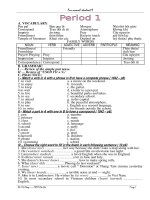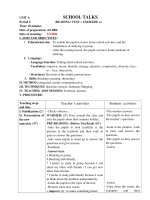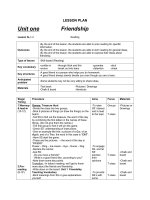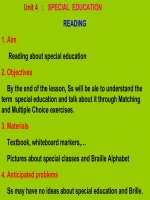Ụnit 1 (p1-p6)
Bạn đang xem bản rút gọn của tài liệu. Xem và tải ngay bản đầy đủ của tài liệu tại đây (360.81 KB, 11 trang )
GIÁO ÁN 11 – BỘ SÁCH CHUẨN
Period: 1
Date of Teaching: 11.8.2008
Lesson: Guide students to learn English effectively
A. WARM UP
Warm-up (8 ms)
Make acquaintance.
Presentation (25 ms)
1. Divide students into 8 groups
2. Ask students to introduce themselves to
each other
- Ask some students to introduce themselves
in front of class
3. Guide students how to work in groups, in
pairs
4. Have students work in groups to discuss
the questions:
1. What do you study English for ?
2. How do you study English well ?
- Go around the class and help them if
necessary.
- Check and give some ideas.
5. Introduce the schedule of English 12 to
students (16 units, 6 themes, 5 parts in each
unit ….)
* Remind students sth. to prepare for learning
English: Textbook, Workbook, notebooks,
dictionary, extra board.
6. Guide students to learn 4 skills
*Give some symbols of writing mistakes
A. WARM UP
- Introduce yourself: monitor, vice-monitor, number of students in class, some special
students in class.
* Vote the group leaders
-Write the names of all members in groups on the piece of paper
* Work in pairs, say something about themselves
Sample
Hello, My name’s …I’m a student. I was born in Dalat in 1991. I’m sixteen years old. I’m
in grade 12, class 12.2 of Chi Lang high school.There are four people in my family: my
father, my mother, my sister and me. My father is a doctor, my mother is a teacher
and my sister is a student. We live in Nguyen Du street. I like playing football and
listening to music in my free time. At school, I like Math best. I think English is a
difficult subject but it is very useful.
* Work in groups: discuss the questions
* Possible answers:
- I study English to sing English songs / play game / use computer / talk to foreigners /
watch films / go abroad / have a good job in the future / get good marks …
- To study English well, I need learning a lot of words / listening to radio regularly /
writing a lot / reading a lot of books / watching television …
* Open books and follow the Book map part.
* Listen to the teacher’s guidance and take notes
1. Reading: read quickly for gist, then more carefully for details. Try to guess words in
context.
2. Speaking: Don’t be shy, don’t be afraid of making mistakes, prepare the knowledge
of the topic at home. Practise speaking English in class.
3. Listening: Listen for certain purposes. Don’t listen to word by word. Use
abbreviation when listening. Practise reading some linking words. Try to listen to the
English programs on TV at home.
4. Writing: Have knowledge of language such as sentence connectors, tenses,
vocabulary ……practise writing at home and correct in groups.
* Students follow the handouts.
Giáo viên: Lô Xuân Thống – Trường THCS và THPT Chi Lăng Page 1
I. OBJECTIVES
Students can say something about themselves.
Students know how to learn four skills effectively and the symbols of mistakes
Students know the importance of learning in groups
II. PREPARATION
Handouts
III. PROCEDURES
GIÁO ÁN 11 – BỘ SÁCH CHUẨN
(prepare handouts)
Test (10 ms)
Complete the paragraphs with appropriate
simple tense forms of verbs. You may use the
verbs more than once.
want, be, live, attend, have
a. Ba is a student at Chu Van An School. Last
year, he (1) Quang Trung School. He (2) at his
present school for three years, and then he
(3) to go to university. Ba (4) an older sister,
Lan. His parents (5) teachers. His family (6) in
an apartment at 52 Trang Tien Road.
* come, practice, have, enjoy, give
b. Lan really (1) playing the violin. She (2)
every morning. On Tuesdays, she (3) a one-
hour violin lesson. Last week, she (4) a
concert. Her family (5) and everyone (6) a
great time. Lan (7) another concert at Tet.
Homework (2 ms)
- Assign homework to students
F. COMMENT
Not necessary to give too many symbols of
writing mistakes
- adj: mistake in using adjective
- adv: mistake in using adverb
- agr: agreement
- art : article
- c : countable noun
- cap: capital
- g : grammar
- p: punctuation
- sp: spelling
- u / c: uncountable noun
- vf: verb form
- voc: vocabulary
- wo: word order
- ww: word wrong
* Answers:
a. 1. attended 2. will be / is going to be 3. wants 4. has
5. are (both) 6. lives
b. 1. enjoys 2. practises 3. has
4. gave 5. came 6. had 7. will give
Prepare Unit one, lesson 1 Reading
- What do you do every day ?
- Vocabulary: Word file about jobs
HILE-READIN.POST-READING EOMEWORK F. COMMENTS
Period: 2
Date of teaching: 12.8.2008
Lesson: READING
A. WARM UP
Ask sts to listen to a song and then answer the questions:
A. WARM UP
Individual work
Listen to the song and answer the questions.
Answers:
Giáo viên: Lô Xuân Thống – Trường THCS và THPT Chi Lăng Page 2
I. OBJECTIVES
By the end of the lesson, students will be able to:
- Understand the passage about friendship
- Identify the main idea
- Guess the meaning in context
- Express ideas about friendship.
II. PREPARATION
Tape, cassette player.
III. PROCEDURES
GIÁO ÁN 11 – BỘ SÁCH CHUẨN
1. What is the name of the song?
2. What’s it about ?
B. PRE-READING
Play the tape
Ask sts to discuss about the question:
What do you think about the friend in the poem?
Get feedback.
Draw a diagram on the board and ask sts to work in groups to
find out 5 words that best describe the qualities of friendship.
T corrects and asks sts to read the passage to know
about the qualities of a true friend.
C. WHILE-READING
Task 1: Fill each blank with a suitable word / phrase.
Guide sts to do task 1, explain the difficult words.
Move around class to give help.
Call on some sts to read the answers aloud.
Correct.
Task 2:
Ask sts to read the text again and answer the questions
1. What is the first quality for true friendship and what does it
tell you?
2. Why are changeable and uncertain people incapable of
true friendship?
3. What is the third quality for true friendship and what does
it tell you?
4. Why must there be a mutual trust between friends?
5. Why can’t people who talk too much keep a friend long ?
6. What is the last quality for true friendship and what does it
tell you?
Call on some pairs to answer the questions in front of the
class.
Give comments on students’ answers.
D. POST-READING
Ask sts to discuss the question “ Why do we need to have
friends ?”
Move around to give help if necessary.
1. “Tiễn bạn lên đường”
2. Friendship
B. PRE-READING
Listen to the poem on page 13
Work in pairs
Discuss the question
Some sts give out their ideas.
“This is a good friend”
Work in groups.
Each group comes to the board and write down one word
from their list.
C. WHILE-READING
Answer
1. mutual 4. acquaintance; friend
2. incapable of 5. give-and-take
3. unselfish 6. loyal to
7. suspicious
Answer
1. The first quality for true friendship is unselfishness. It tells
us/me that a man who is concerned only with his own
interests and feelings cannot be a true friend.
2. Changeable and uncertain people are incapable of true
friendship because they take up an interest with
enthusiasm, but they are soon tired of it, and they feel the
attraction of some new object.
3. The third quality for true friendship is loyalty. It tells
us/me that the true friends must be loyal to each other, and
they must know each other so well that there can be no
suspicions between them.
4. There must be a mutual trust between friends because if
not people cannot feel safe when telling the other their
most intimate secrets.
5. Talkative people can’t keep a friend long because they
cannot keep secret, either their own or those of others’
6. The last quality for true friendship is sympathy. It tells
us/me that to be a true friend you must sympathize with
your friend. Where there’s no mutual sympathy between
friends, there’s no true friendship.
D. POST-READING
Sts call out their answer
Answer key: B
Giáo viên: Lô Xuân Thống – Trường THCS và THPT Chi Lăng Page 3
GIÁO ÁN 11 – BỘ SÁCH CHUẨN
Call a representative of each group reports their group ideas
in front of the class.
Give comments.
E. HOMEWORK
Translate the poem You’ve got a friend into Vietnamese.
F. COMMENTS
Discuss in group of 6
Share ideas
E. HOMEWORK
F. COMMENTS
Period: 3
Date of teaching: 13.8.2008
Lesson: SPEAKING
A. WARM UP
A game
Divide class into groups of 6
Ask sts to describe one student in their group and other
groups guess who he/she is.
Introduce the new material.
“Today we’ll learn speaking part to know how to describe
physical characteristics and personalities of a person”.
B. PRE-SPEAKING
Introduce some words related to describing people by
asking a question
What do you often describe about a person ?
Ask sts to look at the useful language in task 1
Explain some difficult words.
Besides describing appearance of a person, we can also
describe his/her personalities.
Ask sts to do task 2: Discuss and number the personalities in
order of importance in friendship.
Explain the difficult words and teach how to pronounce
these words if necessary.
+ hospitable
+ general
+ sincere
….
C. WHILE-SPEAKING
Activity 1:
Ask sts to look at pictures in task 1 and describe 4 persons
by using suggested words:
Height tall, medium, short, ….
Face square, large, oval, ……
Forehead broad, high, …
A. WARM UP
Work in groups
Describe a person in the group.
Others guess who the peron is.
B. PRE-READING
Sts answer: height, face, forehead, nose, appearance ….
Take notes
Work in groups
Discuss and number.
C. WHILE-READING
Work in pairs
Describe the people and their characteristics.
Ask and answer:
Example:
Giáo viên: Lô Xuân Thống – Trường THCS và THPT Chi Lăng Page 4
I. OBJECTIVES
By the end of the lesson, students will be able to talk about physical characteristics and personalities.
II. PREPARATION
Handouts, board
III. PROCEDURES
GIÁO ÁN 11 – BỘ SÁCH CHUẨN
Nose straight, crooked, …..
Hair black, grey,….
Appearance handsome, beautiful, good-looking ...
Give some model questions:
How old is she ?
Is she tall or short ?
What is she like ?
How is she ?
Go around and give help.
Call on some sts to present in front of the class.
Activity 2: Task 3
Ask sts to work in pairs to play the role of a journalist and an
interviewee whose friend has won the first international
prize in maths.
Make questions:
1. What is his / her name ?
2. When and where was he / she born ?
3. What is he / she like ?
4. What does he / she look like ?
5. What are his / her hobbies ?
6. What made him / her successful in maths ?
7. What do you often do with your friend ?
8. Which characters do you share in common ?
Ask the journalist takes notes and reports the information
Go around to give help.
Call on some pairs to present their conversations
Give comments
D. POST-SPEAKING
Ask and answer about the person you admire greatly.
E. HOMEWORK
- Practise the questions are used to ask about one’
description.
- Write a paragraph ( 50-70 words ) about a person you
admire greatly.
F. COMMENTS
A: Can you describe the boy in the picture ?
B: The boy is tall. He has got an oval face, straight nose. He
wears glasses ….
Work in pairs
Ask and answer about the information.
Role-play: One student is a journalist, another is an
interviewer.
Mention the following questions and words in useful
language.
1. He is Nam
2. He was born in 1980 in Hue.
3. He is fine
4. He is tall and handsome
5. His hobbies are sports, music, …
6. …
Present their conversations in front of the class.
D. POST-READING
Work in pairs
Use the questions in task 3
E. HOMEWORK
F. COMMENTS
Handout: UNIT ONE – SPEAKING (Grade 11)
I. Useful vocabulary
1: Height (chiều cao): medium height (cao trung bình), rather short (hơi thấp), too tall (rất cao) …
2. Face (khuôn mặt): round, square, diamond, oblong, triangular, oval, heart …
1
2
3 4
Giáo viên: Lô Xuân Thống – Trường THCS và THPT Chi Lăng Page 5









